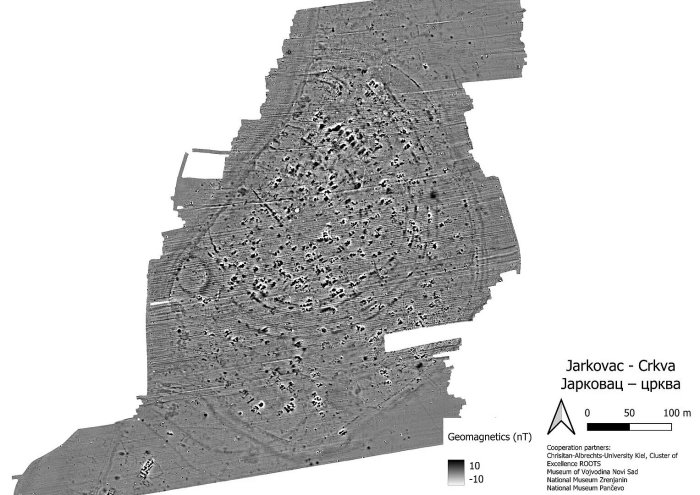Huge Unknown 7,000-Year-Old Vinca Settlement Found In Serbia?

Jan Bartek – AncientPages.com – Scientists report the discovery of a previously unknown Late Neolithic settlement near the Tamiš River in Northeast Serbia.
According to the team leader, Professor Dr. Martin Furholt from the Institute of Prehistoric and Protohistoric Archaeology at Kiel University, “this discovery is of outstanding importance, as hardly any larger Late Neolithic settlements are known in the Serbian Banat region.”
Left: Vinca figurine, British Museum. Credit: Michel wal – CC BY-SA 3.0 – Middle: unknown site of Jarkovac (Serbia). Credit: Cluster ROOOTS/Museum of Vojvodina Novi Sad/National Museum Zrenjanin/National Museum Pancevo – Right: Vinca figurine, the Goddess on the Throne. Credit: Albinfo . CC BY-SA 4.0
Experts from the Museum of Vojvodina in Novi Sad (Serbia), the National Museum Zrenjanin, and the National Museum Pančevo, as well as a team from the ROOTS Cluster of Excellence, made the archaeological discovery.
The newly discovered settlement is situated in close proximity to the modern village of Jarkovac, located in the province of Vojvodina. Employing advanced geophysical methods, the research team successfully mapped the full extent of the settlement earlier in March this year. The settlement covers an expansive area ranging from 11 to 13 hectares and is encircled by a series of four to six ditches. This significant archaeological find provides valuable insights into the historical landscape and settlement patterns of the region.
“A settlement of this size is spectacular. The geophysical data also gives us a clear idea of the structure of the site 7,000 years ago,” says ROOTS doctoral student and co-team leader Fynn Wilkes.
The German-Serbian research team conducted a comprehensive survey of the surrounding area alongside geophysical investigations. The surface material collected indicates that the settlement was a Vinca culture residential site, dating back to 5,400-4,400 B.C.
The Vinca Culture is one of the most advanced prehistoric societies in Europe.
A century ago, a significant archaeological discovery was made on the banks of the Danube River. An elderly man named Panta from the village of Vinca stumbled upon a peculiar clay figurine while working near the riverbank. Perplexed by this mysterious artifact, he brought it to the National Museum in Belgrade, seeking an explanation. Upon examination, the figurine was identified as an object dating back to the late Stone Age.
This chance finding sparked a series of archaeological excavations in the region, unveiling numerous cultural layers and revealing the existence of a vast Neolithic settlement, the largest of its kind in Europe during that era. These excavations have shed light on an ancient civilization that thrived in this area, providing valuable insights into their way of life and cultural practices.
Map of the sites that were surveyed as part of the 2024 spring campaign. Credit: Fynn Wilkes, base map DGM: European Union, 1995–2024
While the recent discovery could potentially be a Vinca settlement, it is essential to explore other possibilities as well. There are also strong indications of influences from the regional Banat culture. Wilkes explains, “This is particularly noteworthy, as only a few settlements with material from the Banat culture are known from the present-day territory of Serbia.”
During a two-week research campaign, the team from the Cluster of Excellence explored several Late Neolithic circular features, known as “rondels,” in Hungary. These rondels are attributed to the Lengyel culture, dating back to 5000/4900–4500/4400 BCE. The researchers collaborated with partners from the Janus Pannonius Museum in Pécs and employed a combination of geophysical technologies and systematic walking surveys of the surrounding areas.
By utilizing both methods, the researchers were able to distinguish the different eras represented at the individual sites more precisely than before. This approach allowed for a clearer differentiation and understanding of the chronological periods associated with these archaeological features.
“This enabled us to re-evaluate some of the already known sites in Hungary. For example, sites that were previously categorized as Late Neolithic circular ditches turned out to be much younger structures,” explains co-team leader Kata Furholt from the Institute of Prehistoric and Protohistoric Archaeology at Kiel University.
A wheel model from the site of Szilvás (Hungary), which can be assigned to the Vučedol culture (3000/2900–2500/2400 BCE). Credit: Fynn Wilkes
Although brief, the fieldwork in Hungary yielded significant insights. One notable finding was re-evaluating a settlement previously dated to the Late Neolithic period. Evidence suggests that this settlement more likely belongs to the Late Copper Age and Early Bronze Age Vucedol culture, spanning from approximately 3000/2900 to 2500/2400 B.C.
Results of the geophysical survey of the previously unknown site of Jarkovac (Serbia). The settlement, whose surface material points to both the Vinča culture and the Banat culture (5400-4400 BCE), has a surface area of up to 13 ha and is surrounded by four to six ditches. The deep black angular anomalies indicate a large number of burnt houses. Credit: Cluster ROOOTS/Museum of Vojvodina Novi Sad/National Museum Zrenjanin/National Museum Pančevo
Additionally, the team comprehensively documented a Late Neolithic circular ditch located in the village of Vokány. These discoveries contribute valuable information to our understanding of the region’s archaeological timeline and cultural heritage.
See also: More Archaeology News
“Southeast Europe is a very important region in order to answer the question how knowledge and technologies spread in early periods of human history and how this was related to social inequalities.
This is where new technologies and knowledge, such as metalworking, first appeared in Europe. With the newly discovered and reclassified sites, we are collecting important data for a better understanding of social inequality and knowledge transfer,” says Professor Martin Furholt in a press release.
Written by Jan Bartek – AncientPages.com Staff Writer








